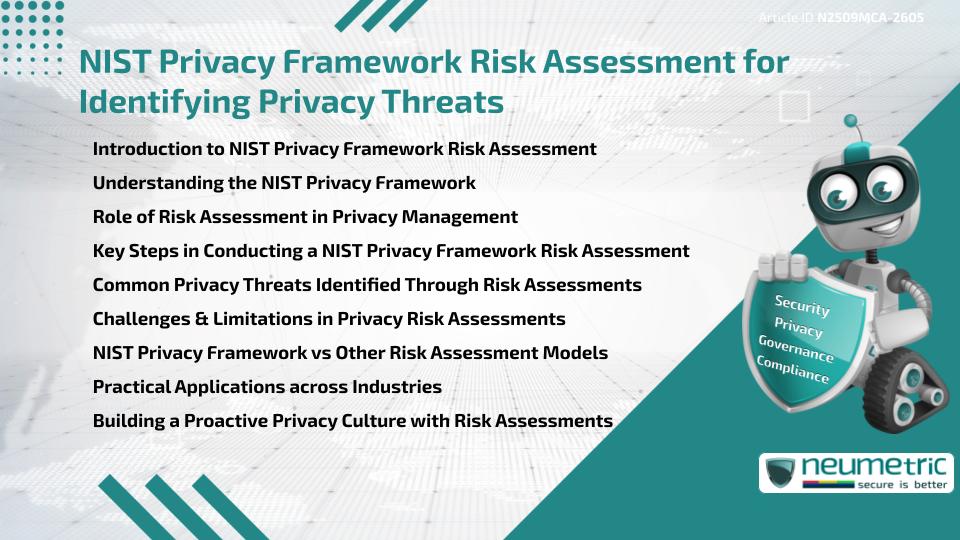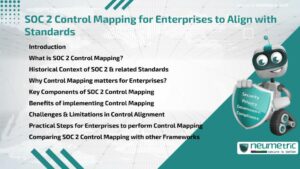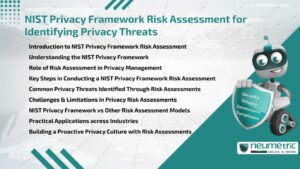Table of Contents
ToggleIntroduction to NIST Privacy Framework Risk Assessment
A NIST Privacy Framework Risk Assessment for Identifying Privacy Threats is an essential process that enables Organisations to evaluate potential Risks to Personal Data. This structured approach ensures that Privacy Threats are detected, prioritised & mitigated before they escalate into serious issues. By aligning with the National Institute of Standards & Technology [NIST] Privacy Framework, Organisations can strengthen Accountability & build Trust with Customers, Employees & Regulators. A well-executed Risk Assessment highlights gaps in controls & creates a roadmap for continuous Privacy improvement.
Understanding the NIST Privacy Framework
The NIST Privacy Framework is a voluntary tool that provides a structured method for managing Privacy Risks. It is modeled after the NIST Cybersecurity Framework but tailored to focus on Privacy. The Framework is divided into three components: Core, Profiles & Implementation Tiers. The Core describes key activities like identifying, governing, controlling & communicating Privacy Risks. Profiles allow Organisations to Customise these activities to their unique business needs. Implementation Tiers indicate how advanced or mature Privacy practices are. Together, these components provide a flexible roadmap for Organisations to enhance Privacy safeguards.
Role of Risk Assessment in Privacy Management
Risk Assessments are the foundation of effective Privacy programs. They provide Organisations with a systematic way to identify Vulnerabilities & Threats that may compromise Personal Data. A NIST Privacy Framework Risk Assessment ensures that Risks are not only documented but also analysed for their potential impact & likelihood. Much like a medical diagnosis helps a doctor prescribe treatment, a Risk Assessment guides Organisations to implement Controls that address actual Threats rather than assumptions.
Key Steps in Conducting a NIST Privacy Framework Risk Assessment
Conducting a NIST Privacy Framework Risk Assessment involves several critical steps:
- Define Scope: Establish which systems, processes & data sets are under Review.
- Identify Risks: List Potential Threats such as Unauthorised access, Data misuse or Insider Risks.
- Analyse Impact: Evaluate how each Threat could affect individuals & the Organisation.
- Prioritise Risks: Rank Threats by Likelihood & severity to allocate resources efficiently.
- Develop Controls: Implement safeguards such as Encryption, Access Management & Training.
- Monitor & Review: Continuously track Threats & adjust Controls as Risks evolve.
These steps create a cycle of improvement that helps maintain effective Privacy protections.
Common Privacy Threats Identified Through Risk Assessments
Risk Assessments often reveal a wide range of Privacy Threats. Common examples include unauthorised Employee access to personal records, improper handling of Third Party Vendor data or weak Security Measures in digital platforms. Data Breaches caused by Phishing or Malware are also frequent findings. In some cases, the misuse of emerging technologies like Artificial Intelligence introduces new concerns. By identifying these Threats early, Organisations can act before they damage reputation or result in Regulatory penalties.
Challenges & Limitations in Privacy Risk Assessments
Although beneficial, Privacy Risk Assessments face practical challenges. Limited resources may prevent Organisations from performing comprehensive assessments. Rapidly evolving technologies can make Risk identification complex. Employees may not always recognise Privacy Risks in daily operations, leading to overlooked Vulnerabilities. Additionally, Risk Assessments may produce subjective results depending on the expertise of auditors. Addressing these limitations requires strong leadership support, proper training & consistent follow-up.
NIST Privacy Framework vs Other Risk Assessment Models
The NIST Privacy Framework is one of several approaches to managing Privacy Risks. The General Data Protection Regulation [GDPR] requires Organisations to conduct Data Protection Impact Assessments [DPIAs]. Similarly, the California Consumer Privacy Act [CCPA] encourages proactive assessments. Unlike these legal requirements, the NIST Privacy Framework is voluntary, but it complements Compliance efforts. Other models such as ISO/IEC 27701 provide detailed guidance on Privacy information management systems. Comparing these approaches helps Organisations select a method that best suits their Regulatory environment & Operational needs.
Practical Applications across Industries
The flexibility of the NIST Privacy Framework allows it to be applied across diverse industries. In Healthcare, it supports Compliance with patient Privacy requirements under HIPAA. In Finance, it ensures protection of Sensitive Customer Information. Technology companies rely on it to manage Risks in Mobile apps, Cloud platforms & Artificial Intelligence systems. Regardless of industry, a NIST Privacy Framework Risk Assessment provides actionable insights that strengthen Privacy safeguards.
Building a Proactive Privacy Culture with Risk Assessments
Risk Assessments are not simply technical exercises; they help build a culture where Privacy is treated as a shared responsibility. Regular assessments remind Employees that Privacy is central to the organisation’s values. When combined with Training & Accountability, they foster proactive behaviors. Instead of reacting to Incidents, Organisations anticipate Threats & act early, reinforcing Resilience & Trust.
Conclusion
A NIST Privacy Framework Risk Assessment for Identifying Privacy Threats equips Organisations with a structured method to detect, evaluate & mitigate Privacy Risks. It ensures that safeguards remain effective & aligned with evolving challenges. By embedding Risk Assessments into routine Governance, Organisations enhance both Compliance & Trust in an increasingly data-driven world.
Takeaways
- A NIST Privacy Framework Risk Assessment systematically identifies Privacy Threats.
- It prioritises Risks based on Likelihood & Impact.
- Risk Assessments reveal Vulnerabilities in processes, technologies & human behavior.
- They foster a proactive Privacy culture across industries.
FAQ
What is a NIST Privacy Framework Risk Assessment?
It is a structured process to identify & evaluate Privacy Threats using the NIST Privacy Framework as a guide.
Why is a Risk Assessment important in Privacy management?
It highlights Vulnerabilities, prioritises Risks & ensures that Controls effectively protect Personal Data.
How does the NIST Privacy Framework help in Risk Assessment?
It provides a structured Core, customisable Profiles & Implementation Tiers to align assessments with organisational needs.
What Privacy Threats are commonly identified?
Common Threats include unauthorised access, data misuse, phishing attacks, weak Vendor practices & Risks from new technologies.
How does this Framework differ from GDPR requirements?
GDPR mandates Data Protection Impact Assessments, while the NIST Privacy Framework offers a voluntary yet complementary structure.
Can small Organisations conduct Privacy Risk Assessments?
Yes, the Framework is flexible & scalable, making it suitable for both Small Businesses & large enterprises.
What challenges exist in Privacy Risk Assessments?
Challenges include limited resources, rapidly changing technologies & the subjective nature of some assessments.
Need help for Security, Privacy, Governance & VAPT?
Neumetric provides organisations the necessary help to achieve their Cybersecurity, Compliance, Governance, Privacy, Certifications & Pentesting needs.
Organisations & Businesses, specifically those which provide SaaS & AI Solutions in the Fintech, BFSI & other regulated sectors, usually need a Cybersecurity Partner for meeting & maintaining the ongoing Security & Privacy needs & requirements of their Enterprise Clients & Privacy conscious Customers.
SOC 2, ISO 27001, ISO 42001, NIST, HIPAA, HECVAT, EU GDPR are some of the Frameworks that are served by Fusion – a SaaS, multimodular, multitenant, centralised, automated, Cybersecurity & Compliance Management system.
Neumetric also provides Expert Services for technical security which covers VAPT for Web Applications, APIs, iOS & Android Mobile Apps, Security Testing for AWS & other Cloud Environments & Cloud Infrastructure & other similar scopes.
Reach out to us by Email or filling out the Contact Form…





